- State transition
- Recall that in a Markov process,
only the last state
determines the next state
that the Markov process will visit:
Ҏ[ X(t+1) = xt+1 | X(1) = x1, X(2) = x2, ..., X(t) = xt ] = Ҏ[ X(t+1) = xt+1 | X(t) = xt ]
- The state at
time t is
X(t)
The state at time t+1 is X(t+1)
Moving from state X(t) to the state X(t+1) is called state transition
- Recall that in a Markov process,
only the last state
determines the next state
that the Markov process will visit:
- One-step transition probability
- Given that the
Markov chain is in
state i at
time t
- The probability that the
Markov chain will be in
state j at
time t+1 is defined as:
Pij = Ҏ[ X(t+1) = j | X(t) = i ]
- Notice that this relationship is
valid for
any value of t.
I.e.:
Pij = Ҏ[ X(t+1) = j | X(t) = i ] = Ҏ[ X(t+2) = j | X(t+1) = i ] = Ҏ[ X(t+3) = j | X(t+2) = i ]The probability Pij is called the one-step (state) transition probability
- Given that the
Markov chain is in
state i at
time t
- Let N denote the
number of states
in the Markov chain
- The collection of
all one-step transition probabilities
forms a matrix:
+- -+ | P11 P12 P13 ... P1N | | P21 P22 P23 ... P2N | P = | .. .. .. .. | | .. .. .. .. | | PN1 PN2 PN3 ... PNN | +- -+
- Property of any one-step transition probability matrix:
P11 + P12 + P13 + ... + P1N = 1 P21 + P22 + P23 + ... + P2N = 1 .. PN1 + PN2 + PN3 + ... + PNN = 1
- Stochastic matrix
- An N×N matrix P is
a stochastic matrix if
∀ i = 1, 2, ..., N: ∑ {j = 1, 2, ..., N} Pij = 1(I.e., every row sum is equal to 1)
- An N×N matrix P is
a stochastic matrix if
- Double stochastic matrix
- An N×N matrix P is
a double stochastic matrix if
∀ i = 1, 2, ..., N: ∑ {j = 1, 2, ..., N} Pij = 1 and: ∀ j = 1, 2, ..., N: ∑ {i = 1, 2, ..., N} Pij = 1(I.e., every row sum and every column sum are equal to 1)
- An N×N matrix P is
a double stochastic matrix if
- The following Markov chain
models the mode of a person:
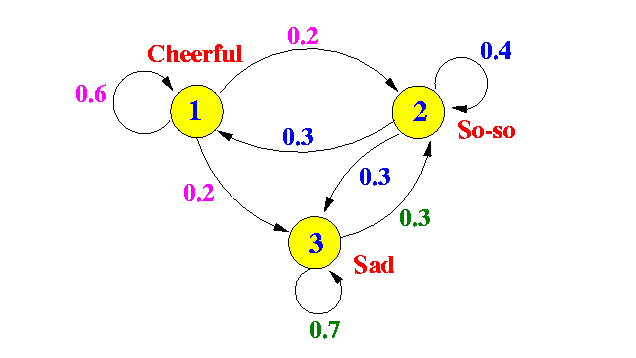
- Some one-state transistion probabilities:
Ҏ[ X(t+1) = Cheerful | X(t) = Cheerful ] = P11 = 0.6 Ҏ[ X(t+1) = So-so | X(t) = Cheerful ] = P11 = 0.2 Ҏ[ X(t+1) = Sad | X(t) = Cheerful ] = P11 = 0.2One-step transition matrix:
+- -+ | 0.6 0.2 0.2 | P = | 0.3 0.4 0.3 | | 0.0 0.3 0.7 | +- -+
- Two steps probability:
P2ij = Ҏ[ X(t+2) = j | X(t) = i ]
- Possible ways to arrive in state j from state i in 2 steps:
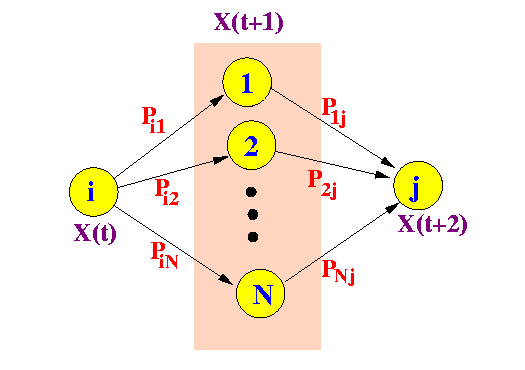
- Therefore:
P2ij = Pi1×P1j + Pi2×P2j + ... + PiN×PNj
Note: this formula is used to multiply 2 matrices !!!
- Relationship between the
2-steps and one-step
transition probability matrices:
P2 = P × P
- Example:
- One-step transition matrix:
+- -+ | 0.6 0.2 0.2 | P = | 0.3 0.4 0.3 | | 0.0 0.3 0.7 | +- -+
- Two-steps transition matrix:
+- -+ +- -+ | 0.6 0.2 0.2 | | 0.6 0.2 0.2 | P2 = | 0.3 0.4 0.3 | × | 0.3 0.4 0.3 | | 0.0 0.3 0.7 | | 0.0 0.3 0.7 | +- -+ +- -+ +- -+ | 0.42 0.26 0.32 | = | 0.30 0.31 0.39 | | 0.09 0.33 0.58 | +- -+
- One-step transition matrix:
- The 2-steps transition matrix can be generalized
to an N-steps process
- It is easy to show that the
N-steps transition matrix PN
is
equal to:
PN = P × P × ... × P
- Example:
> P := matrix(3,3, [0.6, 0.2, 0.2, 0.3, 0.4, 0.3, 0.0, 0.3, 0.7]); P > evalm(P); [0.6 0.2 0.2] [ ] [0.3 0.4 0.3] [ ] [0. 0.3 0.7] P2 > evalm(P&*P); [0.42 0.26 0.32] [ ] [0.30 0.31 0.39] [ ] [0.09 0.33 0.58] P3 > evalm(P&*P&*P); [0.330 0.284 0.386] [ ] [0.273 0.301 0.426] [ ] [0.153 0.324 0.523] P6 > evalm(P&*P&*P&*P&*P&*P); [0.245490 0.304268 0.450242] [ ] [0.237441 0.306157 0.456402] [ ] [0.218961 0.310428 0.470611] P10 > evalm(P&*P&*P&*P&*P&*P&*P&*P&*P&*P&*P); [0.2313863532 0.3075488830 0.4610647637] [ ] [0.2310495033 0.3076271722 0.4613233244] [ ] [0.2302738212 0.3078074437 0.4619187352] P20 > evalm(P&*P&*P&*P&*P&*P&*P&*P&*P&*P&*P&*P&*P&*P&*P&*P&*P&*P&*P&*P); [0.2307712768 0.3076918322 0.4615368910] [ ] [0.2307701600 0.3076920917 0.4615377482] [ ] [0.2307675883 0.3076926893 0.4615397223]It converges !!!
- Initial state π(0):
- Define:
π(0) = ( π1(0), π2(0), ..., πN(0) )
- The initial state π(0) is the vector of probability values that the Markov chain is in state i with probability πi(0)
- Define:
- Example:
- Suppose that initially a person
always starts off
in the "Cheerful" state
Then:
π(0) = ( 1, 0, 0 )
- Suppose that initially a person
always starts off
in the "Cheerful" state
- Starting in the initial state,
a Markov process (chain) will make a
state transition at
each time unit.
- The follow figure shows
the possible ways to
reach the state 1 after
one step:
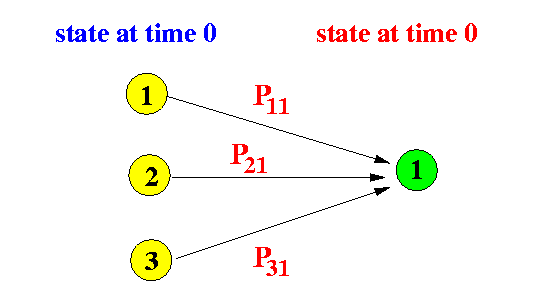
Therefore, the probability that the Markov chain is in state 1 is equal to:
π1(1) = π1(0)P11 + π2(0)P21 + π3(0)P31
- The state probability vector
π(1)
= ( π1(1),
π2(1), ..., πN(1) )
after
one step transition
can be computed
using π(0)
as follows:
π1(1) = π1(0)P11 + π2(0)P21 + π3(0)P31 π2(1) = π1(0)P12 + π2(0)P22 + π3(0)P32 π3(1) = π1(0)P13 + π2(0)P23 + π3(0)P33
Or in matrix form: π(1) = π(0) × PNotice: this is a vector-matrix multiplication (rather than a matrix-vector multiplication)
- Multiple steps:
2 steps: π1(2) = π1(1)P11 + π2(1)P21 + π3(1)P31 π2(2) = π1(1)P12 + π2(1)P22 + π3(1)P32 π3(2) = π1(1)P13 + π2(1)P23 + π3(1)P33 Or: π(2) = π(1) × P = (π(0) × P) × P = π(0) × (P × P) = π(0) × P2
In general: π(k) = π(0) × Pk
- Example:
(Maple) > x := vector([1,0,0]); > x = matrix(3,1, [1,0,0]); > P := matrix(3,3, [0.6, 0.2, 0.2, 0.3, 0.4, 0.3, 0.0, 0.3, 0.7]); x(1) > evalm( x&*P ); [0.6, 0.2, 0.2] x(2) > evalm( x&*P&*P ); [0.42, 0.26, 0.32] x(4) > evalm( x&*P&*P*P&*P ); [0.2832, 0.2954, 0.4214] x(8) > evalm( x&*P&*P*P&*P&*P&*P*P&*P); [0.23490798, 0.30673034, 0.45836168] x(16) > evalm( x&*P&*P*P&*P&*P&*P*P&*P&*P&*P*P&*P&*P&*P*P&*P); [0.2307951062, 0.3076862941, 0.4615185997] x(24) > evalm( x&*P&*P*P&*P&*P&*P*P&*P&*P&*P*P&*P&*P&*P*P&*P&*P&*P*P&*P&*P&*P*P&*P); [0.2307693926, 0.3076922701, 0.4615383374]It converges !!!
- The stationary state is the
following limiting probability:
π(∞) = lim (k → ∞) π(k)
The stationary state is also called the steady state
- Consider the following
Markov chain:
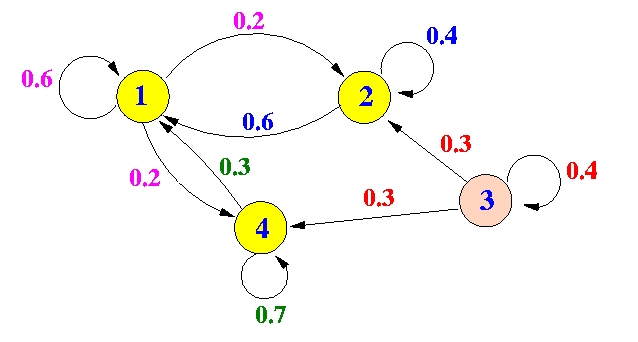
- The multi-step probability matrices:
> P := matrix(4,4, [0.6, 0.2, 0.0, 0.2, \ 0.6, 0.4, 0.0, 0.0, \ 0.0, 0.3, 0.4, 0.3, \ 0.3, 0.0, 0.0, 0.7] ); P2 > evalm( P&*P ); [0.54 0.20 0. 0.26] [ ] [0.60 0.28 0. 0.12] [ ] [0.27 0.24 0.16 0.33] [ ] [0.39 0.06 0. 0.55] P4 > evalm( P&*P&*P&*P ); [0.5130 0.1796 0. 0.3074] [ ] [0.5388 0.2056 0. 0.2556] [ ] [0.4617 0.1794 0.0256 0.3333] [ ] [0.4611 0.1278 0. 0.4111] P4 > evalm( P&*P&*P&*P*P&*P*P&*P ); [0.50167962 0.16834628 0. 0.32997410] [ ] [0.50503884 0.17170552 0. 0.32325564] [ ] [0.49901697 0.16699434 0.00065536 0.33333333] [ ] [0.49496115 0.16162782 0. 0.34341103] P16 > evalm( P&*P&*P&*P*P&*P*P&*P&*P&*P&*P*P&*P*P&*P&*P ); [0.5000282111 0.1666948777 0. 0.3332769112] [ ] [0.5000846332 0.1667513000 0. 0.3331640668] [ ] [ -6 ] [0.4999993559 0.1666668815 0.4294967296 10 0.3333333333] [ ] [0.4999153666 0.1665820333 0. 0.3335025999]Note:
- The probability that the Markov chain is found in state 3 becomes smaller and smaller with time !!!
- Transient state:
- A transient state of a Markov chain is a state where the stationary probability is equal to zero (0)
- Recurrent state:
- A recurrent state of a Markov chain is a non-transient state
- Example:
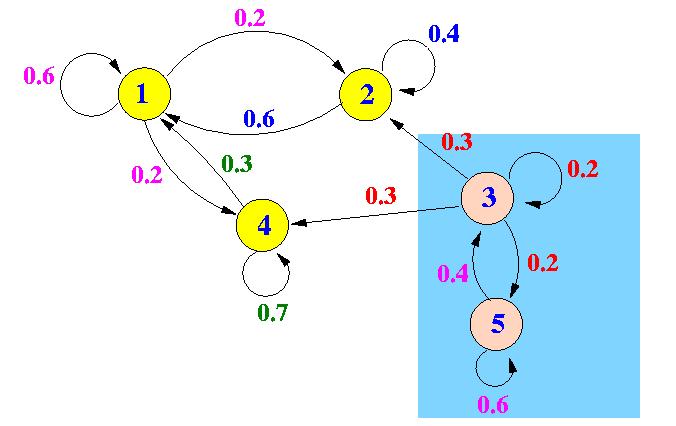
States 3 and 5 are transient states because once the Markov chain leaves theses states, it will never return back to them.
- Periodic states:
- A periodic state
is a special subclass
of recurrent states
A recurrent state i is periodic with a period d if:
p(1)ii = 0 p(2)ii = 0 ... p(d-1)ii = 0 p(d)ii = 1 p(d+1)ii = 0 ....I.e., a periodic state with a period d will re-occur after exactly d steps
Example:
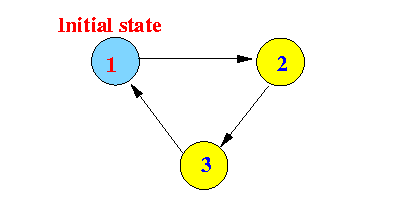
The period of the above Markov process is 3:
p(1)11 = 0 (from state 1, in one step, we reach state 2) p(2)11 = 0 (from state 1, in one steps, we reach state 3) p(3)11 = 1 (from state 1, in one steps, we reach state 1)
- A periodic state
is a special subclass
of recurrent states
- Reachable state:
- A state j is
reachable from
a state i iff:
p(n)ij > 0 for some n > 0I.e., there is a non-zero probability that we end up in state j starting from state i after a finite number of steps n
Example:

- State 1 is reachable from state 3
- State 3 is not reachable from state 1
- A state j is
reachable from
a state i iff:
- Communicating states:
- The states i and j are
communicating states iff:
- State j is reachable from state i, and
- State i is reachable from state j
Example:
- States 1, 2 and 4 are communicating states
- States 3 and 5 are communicating states
- The states i and j are
communicating states iff:
- Chain:
- A chain C is a
set of states where
all members are mutually
communicating
I.e.:
∀ i, j ∈ C: i is reachable from j and j is reachable from i
- A chain C is a
set of states where
all members are mutually
communicating
- Single chain Markov process:
- A single chain Markov process is a Markov process that does not have any transient states
Example:

- The steady state probability
(limiting state probability) of a state is the
likelihood that
the Markov chain is in that state
after a long period of time
Mathematically speaking: we must find this limit
lim {n → ∞} π(n)j
- Lemma 1:
- If a Markov Chain has a
single chain and
no periodic states, then:
the
limiting state probabilities
exists and
independent
from the initial state
I.e.:
lim {n → ∞} π(n)j = π (π is some constant)independent from the value of π(0)j
No proof; but you have seen a few examples above....
- If a Markov Chain has a
single chain and
no periodic states, then:
the
limiting state probabilities
exists and
independent
from the initial state
- Example Markov chain:

One-step probability matrix:
+- -+ | 0.6 0.2 0.2 | P = | 0.3 0.4 0.3 | | 0.0 0.3 0.7 | +- -+
- The example Markov chain
has:
- one single chain
- no recurrent states
According to Lemma 1, the Markov chain has a steady state and the steady state is reached from any initial state
See: click here
- Finding the steady-state probability π
- When Markov chain starts in
initial state π(0)
and make 1 step:
π1(1) = π1(0)P11 + π2(0)P21 + π3(0)P31 π2(1) = π1(0)P12 + π2(0)P22 + π3(0)P32 π3(1) = π1(0)P13 + π2(0)P23 + π3(0)P33 Or: π(1) = π(0) × P
- If the Markov chain is
in the steady state,
and makes one step, the
next state equal to the
steady state.
Therefore, in the steady state π = (π1, π2, π3), we have:
π1 = π1P11 + π2P21 + π3P31 π2 = π1P12 + π2P22 + π3P32 π3 = π1P13 + π2P23 + π3P33 Or: π = πTr × P (Tr = transpose)
These equations will allow you to solve for π = (π1, π2, π3)
- When Markov chain starts in
initial state π(0)
and make 1 step:
- Caveat in solving for π
- The system of equations obtained from the
one step transition probability matrix
is a dependent
system of equations
because
one of the equation is
a linear combination of the other two
equations:
π1 = π1P11 + π2P21 + π3P31 π2 = π1P12 + π2P22 + π3P32 + π3 = π1P13 + π2P23 + π3P33 --------------------------------------- π1 + π2 + π3 = π1(P11 + P12 + P13) + π2(P21 + P22 + P23) + π3(P31 + P32 + P33) Facts: P11 + P12 + P13 = 1 P21 + P22 + P23 = 1 P31 + P32 + P33 = 1
=> π1 + π2 + π3 = π1 + π2 + π3
- In order to obtain a non-dependent
system of equations,
you must
replace any one equation
in the system of equations with
this equation:
π1 + π2 + π3 = 1and then solve it.
- The system of equations obtained from the
one step transition probability matrix
is a dependent
system of equations
because
one of the equation is
a linear combination of the other two
equations:
- Example:

Steady state probability satisfies:
π1 = 0.6 π1 + 0.3 π2 + 0.0 π3 .... (1) π2 = 0.2 π1 + 0.4 π2 + 0.3 π3 .... (2) π3 = 0.2 π1 + 0.3 π2 + 0.7 π3 .... (3)
And: π1 + π2 + π2 = 1 .... (4)
Drop equation (3) and re-write into canonical form:
-0.4 π1 + 0.3 π2 + 0.0 π3 = 0 .... (1) 0.2 π1 - 0.6 π2 + 0.3 π3 = 0 .... (2) π1 + π2 + π3 = 1 .... (4)Solution using Maple:
> eq1 := -0.4*x1 + 0.3*x2 + 0.0*x3 = 0; eq1 := -0.4 x1 + 0.3 x2 = 0 > eq2 := 0.2*x1 - 0.6*x2 + 0.3*x3 = 0; eq2 := 0.2 x1 - 0.6 x2 + 0.3 x3 = 0 > eq3:= x1 + x2 + x3 = 1; eq3 := x1 + x2 + x3 = 1
> solve( {eq1, eq2, eq3}, {x1, x2, x3} ); {x1 = 0.2307692308, x2 = 0.3076923077, x3 = 0.4615384615}Better:
> eq1 := -4/10*x1 + 3/10*x2 = 0; 2 x1 3 x2 eq1 := - ---- + ---- = 0 5 10 > eq2 := 2/10*x1 - 6/10*x2 + 3/10*x3 = 0; x1 3 x2 3 x3 eq2 := ---- - ---- + ---- = 0 5 5 10 > eq3:= x1 + x2 + x3 = 1; eq3 := x1 + x2 + x3 = 1
> solve( {eq1, eq2, eq3}, {x1, x2, x3} ); {x1 = 3/13, x2 = 4/13, x3 = 6/13}
- Consider the Markov transition diagram:

- Focussing only on
the possible ways to get to
the state 1, we see:
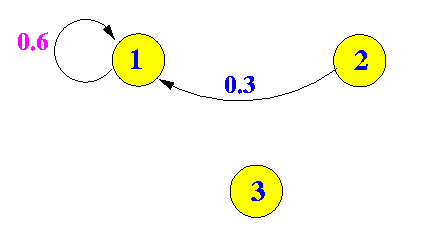
This give rise to the following equilibrium equation:
π1 = 0.6 × π1 + 0.3 × π2 + 0.0 × π3
- Focussing only on
the possible ways to get to
the state 2, we see:
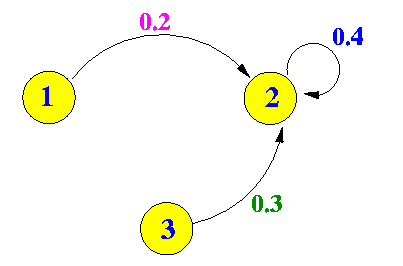
This give rise to the following equilibrium equation:
π2 = 0.2 × π1 + 0.4 × π2 + 0.3 × π3
- Focussing only on
the possible ways to get to
the state 3, we see:
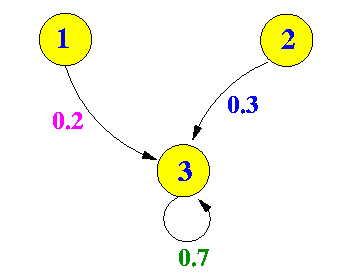
This give rise to the following equilibrium equation:
π3 = 0.2 × π1 + 0.3 × π2 + 0.7 × π3
- Note:
- In more complicated Markov chains,
we may need to use
multiple transitions
to establish
equilibrium equations
- When multiple transitions are used, we treat it like a multi-step transition (See: click here )
- In more complicated Markov chains,
we may need to use
multiple transitions
to establish
equilibrium equations